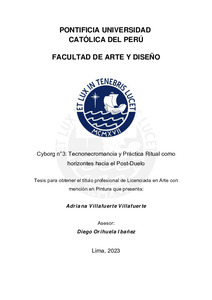| dc.contributor.advisor | Orihuela Ibañez, Diego | |
| dc.contributor.author | Villafuerte Villafuerte, Adriana | |
| dc.date.accessioned | 2023-09-20T21:54:58Z | |
| dc.date.available | 2023-09-20T21:54:58Z | |
| dc.date.created | 2023 | |
| dc.date.issued | 2023-09-20 | |
| dc.identifier.uri | http://hdl.handle.net/20.500.12404/26013 | |
| dc.description.abstract | Entre las experiencias afectivas más fuertes y dolorosas del ser humano, está el
duelo. Este es el proceso universal por el que casi todos pasaremos y que indica el
momento en el que iniciamos un proceso de desprendimiento de lazos afectivos con
el difunto. Nos preguntaríamos, entonces, ¿Con qué estrategias podríamos estar
contando para atravesar esto? ¿Hay manera acaso de superarlo completamente y
hacer que la presencia de la ausencia ya no sea molesta? Para ello, se plantea el
concepto del Cyborg Tecnonecromántico, una promesa de sanación paulatina en la
cual se encapsularían ideas sobre el fallecido que luego son deformadas y
reinterpretadas utilizando diversos recursos internos y externos. Por ello, el trabajo
de investigación en arte atraviesa cuatro capítulos en los que se tocan temas de duelo,
muerte, tecnología y teoría Posthumanista. Este marco teórico se pone a disposición
de una propuesta artística titulada Tecnonecromancia y Cyborg n°3, instalación
compuesta de relicarios tecnológicos que distorsionan sus contenidos dentro de un
contexto de práctica ritual tecnológica. Las piezas que conforman este proyecto son
nueve pequeñas esculturas dispuestas sobre una mesa de acero o suspendidas, una
pieza plana y translúcida central aérea, cuatro dibujos y una pieza sonora que dura
casi 14 minutos. Las metodologías utilizadas fueron la investigación de gabinete,
conversaciones con profesores, psicólogos, coaches ontológicos, estudiantes de
medicina, una tanatóloga y personas que sufrieron la muerte de alguien cercano entre
los años 2020 y 2022 quienes, en algunos casos, ofrecieron archivos de audio para
la pieza sonora mencionada anteriormente. Por el ámbito plástico, se recopilaron
referentes artísticos y se experimentó con diversos materiales y técnicas digitales.
Asimismo, realicé anotaciones de mis propios procesos cognitivos y afectivos a lo
largo de este periodo, que coincidió con la muerte de mi madre en el 2021.
Finalmente, los objetivos de esta tesis son el profundizar en el tema de la muerte y el
duelo para poder comprender el concepto utópico de post-duelo, y dar visibilidad al
tema del duelo y la muerte, un tema tabú al que hemos tenido que enfrentarnos de
manera cruda como sociedad en estos últimos años | es_ES |
| dc.description.abstract | Among the roughest and most painful affective experiences of the human being, is
grieving. This is the universal process that almost all of us will go through and that
indicates the moment in which we begin a process of detachment from affective ties
with the deceased. We would ask ourselves, then, what strategies could we be
counting on to get through this? Is there a way to get over it completely and make the
presence of the absence no longer upsetting? For this, the concept of the
Technonecromantic Cyborg is proposed, a promise of gradual healing in which ideas
about the deceased would be encapsulated, ideas that are later deformed and
reinterpreted using various internal and external resources. For this reason, the
research work on art goes through four chapters in which themes of mourning, death,
technology and Posthumanist theory are touched upon. This theoretical framework is
used to develop an artistic proposal called Tecnonecromancia y Cyborg n°3, an
installation consisting of technological reliquaries that distort their contents within a
context of technological ritual practice. The art pieces that make up this project are
nine small sculptures either arranged on a steel table or suspended mid-air, a flat and
translucent aerial central piece, four drawings and a sound piece that lasts almost 14
minutes. The methodologies used were cabinet research, conversations with
professors, psychologists, ontological coaches, medical students, a thanatologist, and
people who suffered the death of someone close to them between 2020 and 2022
who, in some cases, offered audio files to the aforementioned sound piece. On the
artistic side, references were compiled and various traditional/digital materials and
techniques were experimented with. Likewise, I carried out annotations of my own
cognitive and affective processes throughout this period, which coincided with the
death of my mother in 2021. Finally, the objectives of this thesis are to delve into the
subject of death and grief to be able to understand the utopian concept of postgrieving,
and to give visibility to the issue of mourning and loss, a taboo subject that
have had to face harshly as a society in recent years | es_ES |
| dc.language.iso | spa | es_ES |
| dc.publisher | Pontificia Universidad Católica del Perú | es_ES |
| dc.rights | info:eu-repo/semantics/openAccess | es_ES |
| dc.rights.uri | http://creativecommons.org/licenses/by-nc-sa/2.5/pe/ | * |
| dc.subject | Muerte en el arte | es_ES |
| dc.subject | Pintura--Temas, motivos | es_ES |
| dc.subject | Duelo--Aspectos psicológicos | es_ES |
| dc.title | Cyborg n°3: Tecnonecromancia y Práctica Ritual como horizontes hacia el Post-Duelo | es_ES |
| dc.type | info:eu-repo/semantics/bachelorThesis | es_ES |
| thesis.degree.name | Licenciado en Arte con mención en Pintura | es_ES |
| thesis.degree.level | Título Profesional | es_ES |
| thesis.degree.grantor | Pontificia Universidad Católica del Perú. Facultad de Arte y Diseño | es_ES |
| thesis.degree.discipline | Arte con mención en Pintura | es_ES |
| renati.advisor.dni | 45847359 | |
| renati.advisor.orcid | https://orcid.org/0000-0001-6200-8073 | es_ES |
| renati.author.dni | 47442674 | |
| renati.discipline | 213276 | es_ES |
| renati.juror | Villavicencio Monti, Karla Paola | es_ES |
| renati.juror | Oblitas Jordan, Raura Raquel | es_ES |
| renati.level | https://purl.org/pe-repo/renati/level#tituloProfesional | es_ES |
| renati.type | https://purl.org/pe-repo/renati/type#tesis | es_ES |
| dc.publisher.country | PE | es_ES |
| dc.subject.ocde | https://purl.org/pe-repo/ocde/ford#6.04.01 | es_ES |







